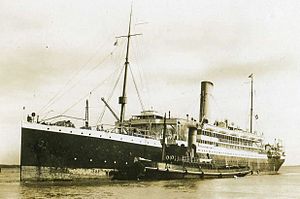HMT Aragon

Aragon in 1908 as a civilian ocean liner
|
|
| History | |
|---|---|
| United Kingdom | |
| Name: |
|
| Namesake: | the Spanish Kingdom of Aragon |
| Owner: |
|
| Operator: |
|
| Port of registry: |
|
| Route: |
|
| Builder: | Harland and Wolff |
| Yard number: | 367 |
| Launched: | 23 February 1905 |
| Completed: | 22 June 1905 |
| Maiden voyage: | 14 July 1905 |
| Out of service: | 30 December 1917 |
| Fate: | sunk by torpedo |
| Status: | wreck |
| General characteristics | |
| Class and type: | A-series |
| Type: | passenger liner |
| Tonnage: | |
| Length: | 513 ft (156 m) |
| Beam: | 60 ft (18 m) |
| Draught: | 31 ft (9.4 m) |
| Installed power: | 827 or 875NHP |
| Propulsion: |
|
| Speed: |
|
| Boats & landing craft carried: |
12 lifeboats, 1 dinghy, 1 gig |
| Capacity: |
|
| Crew: | As troop ship: 200 |
| Armament: | 2 × stern-mounted QF 4.7-inch (120 mm) guns (from 1913) |
| Notes: | |
HMT Aragon, originally RMS Aragon, was a 9,588 GRT transatlantic Royal Mail Ship that served as a troop ship in the First World War. She was built in Ireland in 1905 and was the first of the Royal Mail Steam Packet Company's fleet of "A-liners" that worked regular routes between Southampton and South American ports including Buenos Aires.
In 1913 Aragon became Britain's first defensively armed merchant ship ("DAMS") of modern times. In the First World War she served as a troop ship, taking part in the Gallipoli Campaign in 1915. In 1917 a German submarine sank her in the Mediterranean, killing 610 of the personnel aboard.
Owen Philipps became chairman of RMSP in 1903 and quickly addressed the company's need for larger ships on its South America route. RMSP ordered Aragon from Harland and Wolff built in Belfast, where she was launched on 23 February 1905 by the Countess Fitzwilliam.
He discussed with Charles Parsons the possibility of steam turbine propulsion, which had been demonstrated by the steam launch Turbinia in 1894. The first turbine-powered passenger ship, TS King Edward, had entered service on the Firth of Clyde in 1901 but Philipps decided that another year of evaluation was needed to establish if and how to apply the new form of steam power to commercial ships.
Accordingly, Aragon was built with a pair of conventional quadruple-expansion steam engines that between them developed 827 or 875NHP. They drove twin screws that gave her a speed of 15 knots (28 km/h). She had a single large funnel amidships. She had 12 lifeboats on her boat deck plus a dinghy and a gig aft. Her 1st class dining saloon had a panelled ceiling inlaid with paintings of Christopher Columbus discovering the Americas.
...
Wikipedia
